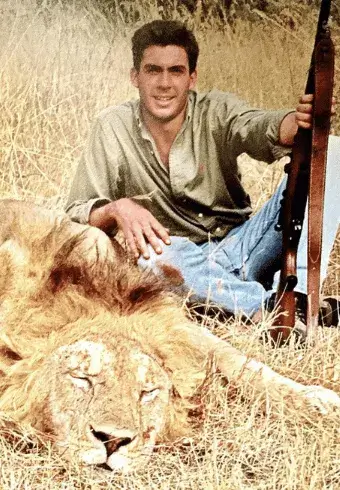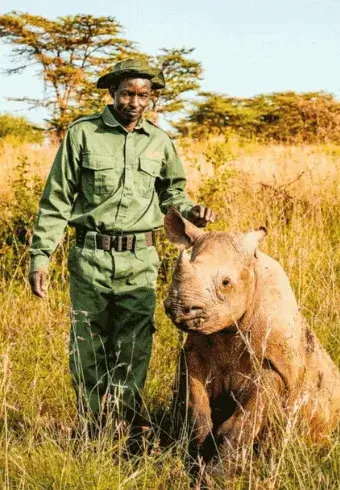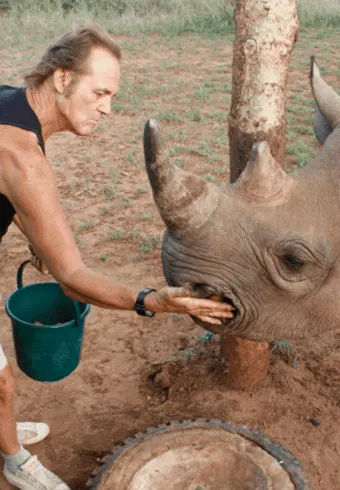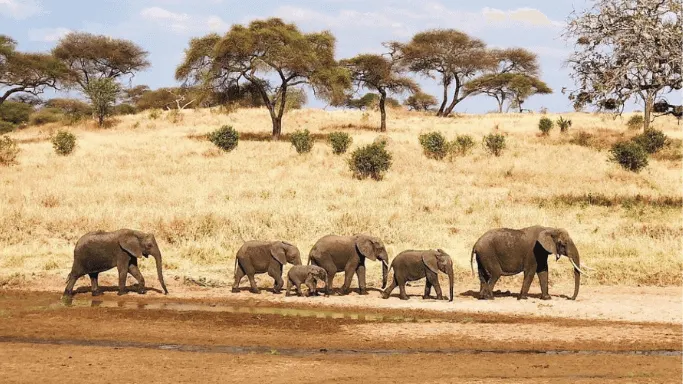Introduction to the Big Five Animals in Tanzania

The term “Big Five Tanzania” represents more than just a tourist attraction, it encapsulates the essence of African wildlife. Originally coined by big-game hunters, the “Big Five” includes five of Africa’s most formidable animals: the lion, leopard, elephant, buffalo, and rhinoceros. These species were historically considered the most dangerous and challenging animals to hunt on foot due to their power, unpredictability, and potential for aggression.
In contemporary Tanzania, the phrase “Big Five” has been redefined. It now signifies the apex of wildlife viewing experiences, offering an opportunity for travelers to witness these magnificent animals thriving in their natural habitats. The Big Five are not only ecological keystones but also crucial to the economic and cultural identity of Tanzanian safari tourism.
Tanzania, with its vast and well-preserved ecosystems, provides one of the best chances on the continent to see the Big Five of Tanzania in a single trip, something not easily achieved elsewhere.
The Origin of the Term “Big Five”
The term was popularized during the colonial period when elite European hunters ventured into Africa in pursuit of trophies. These five animals—lion, leopard, elephant, buffalo, and rhinoceros—posed the greatest risk to hunters and were thus considered prized conquests. Over time, the hunting tradition faded, and the term transitioned from a symbol of conquest to one of conservation and appreciation.
In the case of Big Five Tanzania, the country’s transition from hunting grounds to global conservation hotspot is especially profound. Many of the national parks and game reserves now used for photographic tourism were once reserved for hunting. The efforts of conservationists, both past and present, have transformed these regions into safe havens for wildlife and ecotourism alike.
Why the Big Five Matter in Tanzanian Wildlife Tourism
The Big Five animals in Tanzania are flagship species, each plays a vital ecological role, attracts global attention, and serves as an icon of conservation success or concern. Safari tourism, particularly Big Five travel, forms a critical part of Tanzania’s economy, contributing over 17% to the national GDP and employing hundreds of thousands of people directly and indirectly.

Seeing the Big 5 of Tanzania is the ultimate goal for many tourists. But beyond the thrill lies a deeper significance. These animals are used in government conservation campaigns, wildlife branding, fundraising, and environmental education. Their survival is directly linked to the sustainability of Tanzania’s tourism sector and the health of its ecosystems.
From a conservation perspective, the Big Five serve as “umbrella species,” meaning their protection ensures the preservation of countless other species within their habitats. Without healthy populations of these large mammals, the ecological balance of Tanzania’s savannahs and forests would be at risk.
What Are the Big 5 in Tanzania?
Tanzania is one of the few countries where you can still see all members of the Big Five in the wild. The Big Five in Tanzania are:
- Lion (Panthera leo)
- Leopard (Panthera pardus)
- African Elephant (Loxodonta africana)
- African Buffalo (Syncerus caffer)
- Black and White Rhinoceros (Diceros bicornis & Ceratotherium simum)
These species are primarily found within Tanzania’s premier national parks and conservation areas, particularly the Serengeti, Ngorongoro Conservation Area, Tarangire, and Lake Manyara National Parks.
1. Lion: The King of the Savannah
Lions in Tanzania are a cornerstone of Big Five safari experiences, especially within the Serengeti-Mara ecosystem. Tanzania is home to one of the largest lion populations in Africa, with estimates suggesting over 14,000 individuals—almost half of the continent’s remaining lions.
Lions in Tanzania live in social units known as prides, composed of related females and one or more male coalitions. Their cooperative hunting strategies, complex social dynamics, and dominance in the food chain make them captivating subjects for wildlife enthusiasts and researchers alike.
However, lion populations face serious challenges. These include habitat loss due to human expansion, retaliatory killings by pastoralists, poorly regulated trophy hunting in buffer zones, and even disease outbreaks. Conservation programs in Tanzania, including the Lion Guardians initiative, focus on community engagement, reducing human-wildlife conflict, and minimizing infanticide resulting from pride takeovers linked to trophy hunting.
2. Leopard: The Elusive Predator

Leopards are the most secretive and adaptable of the Big 5 Tanzania species. They are solitary, nocturnal, and known for their exceptional camouflage and tree-climbing prowess. Although widely distributed across Tanzania—including Serengeti, Lake Manyara, and the Selous—leopard sightings require patience and a sharp eye.
Their stealthy nature makes them less vulnerable to some threats faced by other Big Five animals, but they are not immune to danger. Habitat fragmentation, snaring, illegal skin trade, and mismanaged hunting quotas have contributed to localized population declines.
Behavioral studies reveal that leopard cubs face high mortality, with infanticide by incoming males a major threat. Conservationists emphasize protecting mature males and minimizing human-leopard conflict to maintain viable populations.
3. Elephant: The Gentle Giant of Tanzania
Tanzania is home to approximately 60,000 elephants, primarily concentrated in Tarangire, Ruaha, and Serengeti National Parks. The African elephant, the largest land mammal, plays a crucial ecological role—engineering the landscape by knocking down trees, digging water holes, and dispersing seeds.
Elephants in Tanzania live in complex matriarchal societies and are known for their intelligence, long memory, and deep emotional bonds. Their long-range migratory behavior has been tracked across protected areas, making wildlife corridors essential to their survival.
Despite being listed as “Vulnerable” by the IUCN, elephants remain highly targeted by poachers due to the illegal ivory trade. Tanzania’s commitment to elephant conservation includes stricter anti-poaching measures, high-tech surveillance (e.g., drones and GPS tracking), and community-based initiatives that discourage human-elephant conflict through innovative deterrents like bee-fences and chili barriers.
4. Buffalo: The Unsung Powerhouse of the Plains
The African buffalo (Syncerus caffer) is often underestimated compared to the more photogenic members of the Big Five Tanzania lineup, yet it is one of the most ecologically significant and formidable mammals in Tanzania’s savannah ecosystems. With a total African population estimated between half a million and a million individuals, buffalo remain the most numerous of the Big Five, and in Tanzania, they are still widely distributed across major national parks, particularly the Serengeti and Ngorongoro Conservation Area

Buffalo are highly social and live in dynamic fission-fusion herds, with group sizes ranging from a few dozen to over a thousand individuals depending on season and habitat. Males frequently move between bachelor groups and breeding herds, especially during the mating season. Their sheer strength, unpredictable nature, and strong herd protection mechanisms make them one of the most dangerous animals to approach on foot—earning them a prominent place in the historical Big Five list.
Though listed as a species of “Least Concern” by the IUCN, buffalo populations are not without threats. Habitat destruction due to agricultural encroachment, illegal bushmeat hunting, and proximity to roads have all contributed to reduced densities in some areas. Studies show that buffalo tend to thrive in more remote protected areas, farther from human settlement, which highlights the importance of preserving core wildlife zones in Tanzania.
Interestingly, buffalo display regionally variable behavior. In open savannahs like the Serengeti, massive herds dominate the landscape and play a major role in predator-prey dynamics, particularly with lions. In forested or hilly environments, they tend to gather in smaller, less conspicuous groups, especially around natural clearings known as glades—an ecological behavior that underscores the need for diverse habitat types within Tanzania’s protected network.
5. Rhinoceros: The Vanishing Titan of Tanzania
Of all the Big Five animals in Tanzania, the rhinoceros—both black (Diceros bicornis) and white (Ceratotherium simum)—faces the gravest threat to survival. Decimated by decades of relentless poaching driven by demand for their horns, these ancient herbivores now exist in highly controlled, intensely protected environments. In Tanzania, viable rhino populations are found primarily in the Ngorongoro Crater and a handful of secure conservation zones where they are monitored around the clock.

The black rhinoceros, once widespread across East Africa, has suffered a 98% population decline since the 1960s. Only about 5,000 individuals remain in the wild across Africa, with Tanzania hosting a small but genetically important population. The white rhinoceros, particularly the southern subspecies, is less common in Tanzania but has been included in selected conservation programs. The western black rhinoceros subspecies (D. b. longipes), once native to West and Central Africa, has already been declared extinct.
Rhinoceroses are solitary, highly territorial animals that rely on scent marking and physical scrapes to communicate. Mating is rare and often aggressive. In Tanzania, behavioral insights such as territorial range size and social spacing have become critical in designing reintroduction strategies. For example, some individuals require vast areas to establish stable ranges, while others may suffer from stress and increased aggression when released into confined sanctuaries.
Despite ongoing conservation successes—like guarded rhino sanctuaries and anti-poaching enforcement using helicopters, rangers, and surveillance systems—rhinos remain critically endangered. Their horns continue to command astronomical prices on black markets, making even museum specimens a target. In captivity, stress and poor breeding success have further complicated conservation, prompting a cautious approach to rhino translocations and population restoration efforts in Tanzania.
Can You See the Big Five in Tanzania?
Yes—Tanzania is one of the few countries in the world where travelers can reliably see all five members of the Big Fivein the wild. From the lion-filled grasslands of the Serengeti to the rhino-protected Ngorongoro Crater, the opportunity to encounter all five species in one journey makes Big Five travel in Tanzania a bucket-list experience.
Best National Parks for Big 5 Sightings
- Serengeti National Park: Tanzania’s most famous park and a global icon for wildlife. Home to all five species, the Serengeti is especially known for large prides of lions, elusive leopards along riverbanks, and the Great Wildebeest Migration—a prime draw for predators.
- Ngorongoro Crater: This natural amphitheater is considered the most reliable location to see all Big Five animals in Tanzania in a single day. The crater’s enclosed ecosystem supports resident populations of lion, buffalo, elephant, and even the rare black rhino.
- Tarangire National Park: Known for its massive elephant herds and large baobab trees, Tarangire also offers chances to see lions, leopards, and buffalo.
- Lake Manyara National Park: Famous for its tree-climbing lions and bird diversity, Lake Manyara can surprise visitors with sightings of elephants and leopards in dense woodlands.
Seasonal Tips for Spotting the Big Five
While Big Five Tanzania safaris can be enjoyed year-round, the dry season (June to October) is the best time for clear sightings. During this period, vegetation is sparse, and animals congregate near rivers and waterholes, making them easier to spot.
The wet season (November to May) brings lush landscapes, migratory birds, and fewer crowds—but it may also spread out the wildlife, requiring more time and expert guidance to track the Big Five animals in Tanzania.
How Safari Guides Help You Find the Big 5 of Tanzania
Professional Tanzanian safari guides are vital to a successful Big Five travel experience. Their expertise in tracking animal behavior, reading signs in the wild, and using radio communications with other rangers dramatically increases your chances of seeing the Big Five of Tanzania.
Guides not only help you locate the animals, but also interpret their behavior—whether it’s a lioness stalking prey, a bull elephant scenting the air, or a leopard retreating into the trees. Their knowledge adds depth and meaning to each sighting, transforming your trip from a viewing experience into an educational journey.
The Role of Conservation in Protecting Tanzania’s Big Five
The survival of the Big Five animals in Tanzania hinges on an intricate balance between science, community collaboration, and political will. Over the years, Tanzania has become a continental leader in conservation, with more than one-third of its land designated as protected areas. These national parks and reserves—home to the big five Tanzaniaspecies—are more than safari destinations; they are critical biodiversity strongholds.
Among the most notable victories in recent decades has been the reduction in elephant poaching across key regions like Tarangire and Serengeti. This turnaround didn’t happen by chance. It stemmed from robust anti-poaching initiatives, including well-trained ranger forces, intelligence-driven patrols, and the deployment of surveillance technologies such as drones and GPS tracking collars. However, enforcement alone is not enough. Conservationists have learned that true sustainability comes from understanding the behavioral patterns of the Big Five—how lions organize in prides, when elephants migrate, where leopards establish territories. These patterns are now central to park management strategies, helping determine where corridors should be established, when patrols should increase, and how tourism routes are designed.

Perhaps the most transformative force in modern Tanzanian conservation is the rise of community-based programs. In areas where local people once viewed wildlife as a threat to their livelihoods, there is now a growing sense of ownership and pride. Villagers work as rangers, manage Wildlife Management Areas, and earn income through eco-tourism. When rural communities benefit directly from the presence of big five animals in Tanzania, conservation becomes a shared mission rather than an imposed restriction.
The synergy between traditional ecological knowledge, modern conservation science, and community empowerment has turned Tanzania into a model for the rest of the continent. And at the heart of this model are five charismatic species whose fate continues to inspire global attention.
Big Five Safari Destinations in Tanzania
Few places on Earth offer such an immersive and authentic wildlife experience as Tanzania. For travelers chasing the dream of seeing the Big Five Tanzania animals in the wild, the country’s varied ecosystems present a series of extraordinary theaters in which nature performs its rawest and most powerful acts.
i) Serengeti National Park
The Serengeti, arguably the most iconic safari destination in the world, delivers a spectacle of life on an unparalleled scale. While millions flock to witness the Great Migration, it’s the park’s year-round residents—the lions, leopards, elephants, buffalo, and occasional black rhino—that round out the Serengeti’s status as a true Big Five stronghold. Early mornings here often reveal prides of lions greeting the sunrise or leopards draped lazily over fig tree branches after a nocturnal hunt. The Moru Kopjes area, with its rocky outcrops and dense thickets, offers rare sightings of black rhinos, still protected under intense surveillance.
ii) Ngorongoro Crater
To the southeast lies Ngorongoro Crater, a natural wonder shaped by ancient volcanic activity and now one of the best places on the planet to see all five species in a single game drive. The caldera’s enclosed geography creates an ecosystem teeming with life—from the old tusker elephants grazing by the Lerai Forest to elusive leopards lurking near the rim’s edge. Even the highly endangered black rhino finds sanctuary within the crater’s boundaries, making it the definitive Big Five Tanzania safari hotspot.
iii)Tarangire National Park
And yet, not all experiences hinge on global fame. Tarangire National Park, with its sweeping savannas and ancient baobabs, offers a more contemplative connection with nature. Known for vast elephant herds and predator activity, it complements the more visited parks with a quieter, equally rewarding encounter with the Big Five.
iv) Lake Manyara National Park
Similarly, Lake Manyara National Park, tucked against the Rift Valley wall, surprises visitors with unique behaviors—such as lions that climb trees, a phenomenon rarely seen elsewhere.
These landscapes, diverse yet interconnected, ensure that Tanzania’s Big Five can be experienced not as a checklist, but as a flowing narrative of ecology, survival, and wonder.
Conservation Status of Each Big Five Species
In Tanzania, the Big Five animals are not only iconic; they also serve as an ecological barometer. The rise or fall of their populations reflects the broader health of the ecosystems they inhabit. Yet despite their fame, each species faces its own unique conservation challenges, shaped by global demand, environmental pressures, and biological vulnerability.
i) Lion (Simba)
The lion, long considered the symbol of African wilderness, is now classified as “Vulnerable” by the IUCN. Though Tanzania holds one of the largest lion populations in the world, their numbers are declining. The core threats include retaliatory killings due to livestock predation, loss of prey base, and poorly managed trophy hunting in some peripheral areas. Even within protected regions like the Serengeti, careful monitoring is essential to ensure population stability. In the Ngorongoro Conservation Area, for example, inbreeding due to isolation has raised concerns about genetic health.
ii) Leopard
The leopard is listed as “Near Threatened,” and while still widely distributed across Tanzania’s national parks and reserves, it’s also one of the least understood. Its elusive nature has both protected and imperiled it. Leopards are highly adaptable, often living near human settlements without detection, but this proximity can turn fatal if they’re caught attacking livestock. Their vulnerability lies in their solitary habits—one adult removed from a habitat can leave a large void.
iii) Elephants
Elephants, though still relatively numerous in Tanzania, are under constant pressure. The country has experienced both collapse and recovery in its elephant populations. The savanna elephant is currently considered “Vulnerable,” and while the Selous Game Reserve lost tens of thousands to poaching between 2009 and 2014, recent anti-poaching efforts have started to reverse the trend. In parks like Tarangire and Ruaha, elephant numbers are more stable, but the demand for ivory remains a dangerous variable.
iv) African buffalo
The African buffalo stands out among the Big Five for being the only species currently listed as “Least Concern.” Yet its abundance shouldn’t breed complacency. In areas close to human settlement, buffalo are often targeted for bushmeat and can be vectors for diseases like bovine tuberculosis, leading to culling campaigns. Their conservation status is secure for now, but it is tightly linked to the strength and integrity of Tanzania’s protected areas.
v) black rhinoceros
Lastly, the black rhinoceros, and to a lesser extent the southern white rhino, are the most critically endangered members of the Big Five. The black rhino has suffered a catastrophic decline across its range due to relentless poaching for its horn. In Tanzania, only small, carefully monitored populations remain—primarily in Ngorongoro and private conservation sanctuaries. These animals live under armed guard and constant surveillance, a testament to both their value and their fragility.
Across these five species, conservation status is not merely a scientific label—it is a call to action. Each listing speaks to a broader narrative about human values, ecological responsibility, and the urgency of protecting Tanzania’s natural heritage.
Behavioral Traits That Make Each Species Unique
Beyond their size and strength, what truly distinguishes the Big Five animals in Tanzania and others are their fascinating behavioral traits—each evolved to help them survive in Africa’s diverse and often unforgiving landscapes. Understanding these behaviors isn’t just intellectually intriguing; it’s also central to their conservation.
i) Lion (Simba)
Take the lion, for instance. As the only social feline, lions live in structured prides where cooperation plays a key role in hunting, cub-rearing, and territorial defense. The size and stability of a pride directly affect its reproductive success. Yet, the very structure of lion society also makes them vulnerable. When new male coalitions take over a pride, they often kill off existing cubs—a natural, but devastating behavior known as infanticide. This dynamic becomes even more complex when humans disrupt the social order by targeting dominant males in trophy hunting or retaliation events, triggering cascades of pride takeovers and reproductive loss.
ii) Leopard
Leopards, in contrast, are the embodiment of stealth and solitude. Their behavior is defined by a need to remain unseen—hunting at night, hiding kills in trees, and marking vast individual territories that rarely overlap. Males roam across multiple female territories, and competition is fierce. Cubs are often victims of infanticide by incoming males, with survival hinging on the mother’s ability to keep them hidden. Because of their secretive habits, leopard populations are notoriously hard to monitor, and conservation efforts often lack the behavioral data needed to shape precise policies.
iii) Elephants
Elephants are perhaps the most behaviorally complex of the Big Five. Living in matriarch-led herds, they demonstrate remarkable memory, empathy, and social structure. Their migratory instincts are deeply ingrained, guiding them over hundreds of kilometers between wet and dry season ranges. These routes, often passed down through generations, are critical for survival. Unfortunately, as human settlements expand, these ancient corridors are increasingly blocked, causing stress, nutritional deficiency, and heightened conflict with communities. Understanding elephant memory and movement patterns has become essential for planning protected corridors and preventing destructive encounters.
iv) Buffalo
Buffalo, while less studied than other Big Five members, are no less intriguing. They live in large herds with loose fission-fusion dynamics, where groups split and rejoin based on environmental conditions. Males often travel in bachelor herds or alone, rejoining females during mating seasons. Buffalo herds are known for their unpredictable and aggressive defense strategies against predators. Their group cohesion and strength in numbers make them formidable and important as prey base stabilizers for large carnivores like lions.
v) black rhinoceros
Finally, the black rhinoceros exemplifies the challenges of solitary life in a dangerous world. Highly territorial, rhinos use scent-marking and dung heaps to communicate. Unlike elephants or lions, they do not form groups, which makes each individual more vulnerable to threats like poaching. Their mating rituals are tense and often aggressive, and home range sizes vary wildly depending on habitat quality. In captivity, rhinos often display stereotypic behaviors like pacing or horn-rubbing—signs of chronic stress that have led to significant changes in zoo and sanctuary design.
These behaviors are more than evolutionary quirks. They are blueprints for survival—and guides for us, as stewards of Tanzania’s wildlife, to understand how best to protect each species in its natural rhythm and space.
Reintroductions and Captive Breeding Programs in Tanzania
In a perfect world, the Big Five would thrive naturally across Tanzania’s wild landscapes without human interference. But reality dictates otherwise. Habitat fragmentation, poaching, and genetic bottlenecks have made reintroduction and captive breeding essential tools in the conservation toolbox—especially for species like the rhinoceros and, to a lesser degree, lions and elephants.

Black rhino reintroductions are among Tanzania’s most delicate and guarded conservation efforts. Small founder populations have been established in high-security zones such as the Ngorongoro Crater and Mkomazi National Park. These reintroductions often rely on individuals relocated from other countries or private sanctuaries. Yet success is never guaranteed. Behavioral factors, such as territory establishment, dominance disputes among males, and the need for large ranging areas, complicate every release. The risks are high, but so are the rewards. Each successfully established rhino helps rebuild a population devastated by decades of poaching.
For lions, reintroduction efforts are less common in Tanzania, where natural populations still exist in relatively healthy numbers in core protected areas. However, in locations where prides have been eliminated, careful rewilding is sometimes considered. Behavioral compatibility is a major concern—introducing unfamiliar lions can trigger aggression, infanticide, or pride dissolution. Soft-release strategies, in which animals acclimate in controlled environments before full release, are used to mitigate these risks.
Elephant translocations are more frequently applied, especially when population pressure within a park exceeds ecological capacity or threatens surrounding communities. Moving elephants is an enormous logistical challenge, but it has proven effective when executed properly. However, problems arise when herds are fragmented or when bulls are moved without matriarchal guidance. Behavioral stress, altered movement patterns, and increased human-elephant conflict can result if reintroductions aren’t carefully managed.
Captive breeding, especially for black rhinos, plays a smaller but strategic role. Tanzania maintains a few secure facilities for breeding and potential genetic supplementation. However, breeding success in captivity is notoriously difficult for many Big Five species due to social incompatibility, stress, and reproductive issues linked to space and environmental enrichment. For example, studies show that white rhinos often fail to reproduce in confined zoos unless paired under highly specific social conditions and provided with large, naturalistic enclosures.
Ultimately, while reintroduction and captive breeding are not substitutes for strong in-situ conservation, they serve as lifelines—especially when extinction is looming. Their success depends not only on biological science, but on deep behavioral understanding, community cooperation, and long-term ecological planning.
Big Five Travel Tips and Responsible Tourism
Traveling to see the Big Five in Tanzania is a privilege, and with that comes responsibility. Safari tourism, if practiced ethically, plays a vital role in conserving wildlife and supporting local economies. But it also demands awareness—of the environment, the culture, and the creatures you’ve come to admire.
First and foremost, choose a safari operator that emphasizes low-impact, conservation-driven travel. Reputable companies hire local guides, follow wildlife viewing codes of conduct, and contribute financially to conservation efforts and community programs. Ask questions: Do they support anti-poaching initiatives? Are their camps eco-certified? Do they limit vehicle numbers per sighting to minimize animal stress?
When observing the Big Five animals in Tanzania, patience is key. You’re not in a zoo—you’re in the wild. Sometimes, it may take hours to find a lion pride or track down a solitary leopard. But these quiet moments, punctuated by dramatic reveals, are what make a Tanzanian safari unforgettable. Respect distances, stay quiet, and follow your guide’s instructions—they are trained to read both landscapes and animal behavior.
It’s also worth preparing properly. Dress in neutral colors to blend in with the environment and bring a good pair of binoculars for spotting elusive species like leopards or black rhinos. Sunscreen, hats, and layers are essential for changing temperatures throughout the day. For photography, a quality zoom lens is invaluable—especially for capturing intimate moments without disturbing wildlife.
Supporting local economies goes hand in hand with supporting wildlife. When purchasing souvenirs or booking lodges, prioritize Tanzanian-owned businesses and certified cultural experiences. By doing so, your presence contributes not just to animal conservation, but also to the wellbeing of the people who live alongside them.
In the end, the best safari travelers are those who leave no trace—except for a deeper understanding of the land, its people, and the profound lives of the Big Five of Tanzania.
The Economic and Cultural Impact of the Big Five
To understand the significance of the Big Five animals in Tanzania, one must look beyond their biological roles. These species are woven into the fabric of the nation’s economy, culture, and identity. They are not just animals to observe; they are livelihoods to protect and legacies to uphold.
Safari tourism, driven largely by the allure of the Big Five, is a cornerstone of Tanzania’s economy. Wildlife-based tourism contributes approximately 17% to the nation’s GDP and is one of the top sources of foreign exchange. The economic ripple effect is vast—supporting hotels, tour operators, artisan markets, park management, and entire communities that live adjacent to protected areas. The presence of healthy lion prides or rhino sanctuaries can dramatically boost the fortunes of surrounding villages through employment and conservation-linked enterprise.

But economics is only part of the story. The Big Five of Tanzania also hold cultural resonance, particularly among indigenous and pastoralist communities. The Maasai, Datoga, and Hadzabe peoples have long interacted with wildlife—sometimes in conflict, sometimes in reverence. Lions, for instance, feature in rites of passage and oral traditions, symbolizing strength, courage, and ancestral power. Elephants are admired for their wisdom and are often associated with rain and fertility. Even the fierce buffalo and elusive leopard find their way into clan symbols and spiritual lore.
These deep-rooted associations can be a powerful force for conservation when approached respectfully. Increasingly, conservation projects in Tanzania are integrating local narratives, promoting cultural pride alongside environmental stewardship. Programs that train community members as guides or wildlife monitors build bridges between ancestral knowledge and modern ecology.
At a time when wildlife across Africa is under threat, the enduring presence of the Big Five in Tanzania speaks to a national commitment—to protect not just the animals, but also the values and economies they sustain. They are, in every sense, Tanzania’s living heritage.
Future Outlook for Big Five Animals in Tanzania
The future of the Big Five in Tanzania balances delicately between hope and uncertainty. On one hand, the country has made tremendous strides—its protected area network is among the largest in Africa, poaching has declined in some regions, and community engagement is evolving conservation from a top-down directive into a shared mission. On the other hand, mounting pressures from climate change, population growth, and international wildlife crime syndicates threaten to undermine these hard-earned gains.
Technological innovation offers a glimmer of promise. Conservationists now deploy real-time GPS tracking collars on elephants and lions, drone surveillance over rhino territories, and remote camera traps to monitor elusive leopards in the bush. Artificial intelligence is beginning to play a role in analyzing animal movement patterns, helping park rangers anticipate poaching risks before they happen. These tools not only improve efficiency but allow rangers to respond with precision, reducing pressure on limited resources.
Equally promising is the rise of youth-led conservation movements in Tanzania. Across the country, young Tanzanians are training as ecologists, park rangers, drone pilots, and eco-tourism entrepreneurs. Environmental education is making its way into schools, inspiring the next generation to value and protect the Big Five Tanzania species as part of their own national identity. Initiatives like Earth Guardians and Roots & Shoots are connecting youth with wildlife advocacy, science, and global networks of support.

Still, challenges remain immense. For rhinoceros populations to recover, international demand for horn must be eradicated. For elephants to thrive, their migratory corridors must remain intact. For lions and leopards, human-wildlife conflict must be transformed from confrontation into coexistence. This will require sustained international funding, transparent governance, and—most critically—continued community empowerment.
The story of the big five animals in Tanzania is far from finished. It is a living narrative of resilience, reinvention, and reverence. Whether their future is one of extinction or expansion depends not just on policy and patrols, but on our collective will to protect what remains wild.
FAQs About the Big 5 in Tanzania
Yes, absolutely—and Tanzania is one of the few countries where it’s still realistically possible to encounter all five species in a single journey. Destinations like Serengeti National Park and the Ngorongoro Crater offer optimal conditions for observing lions, elephants, buffalo, and leopards. For black rhinos, sightings are rarer but very possible—especially in Ngorongoro, where intensive conservation has preserved a small but visible population. In fact, the Ngorongoro Tanzania Big Five safari hotspot is one of the most reliable places on Earth to complete the full set.
The term refers to five large African mammals: lion, leopard, African elephant, buffalo, and rhinoceros (both black and white species). While the origins of the phrase come from hunting terminology, its meaning today is centered on conservation and appreciation of these magnificent creatures. In Tanzania, these animals are found in multiple ecosystems—from the grasslands of the Serengeti to the forests of Lake Manyara and the volcanic floor of Ngorongoro.
Dry season—from June to October—is considered the ideal window for Big Five travel. Vegetation is sparse, animals congregate around water sources, and safari vehicles can access more remote areas with ease. That said, Tanzania’s Big Five are present year-round, and some travelers prefer the green season (November–May) for its lush beauty, dramatic skies, and fewer tourists.
Ngorongoro Crater is the only single park in Tanzania where seeing all Big Five animals in one day is genuinely achievable. The crater’s geography creates a self-contained ecosystem with a high density of game, increasing your chances of spotting even the elusive rhino. However, spreading your itinerary across Serengeti, Tarangire, and Lake Manyara gives a broader view of these species in different habitats and behaviors.
Yes. All five species are legally protected under Tanzanian law and international agreements like CITES. Some—like the rhino and elephant—are under round-the-clock surveillance in certain parks due to the high risk of poaching. Conservation organizations, local communities, and government authorities work together to ensure the survival of the big five Tanzania animals for generations to come.
While several African nations offer Big Five safaris, Tanzania stands out for its unparalleled combination of wildlife density, ecosystem variety, and conservation integrity. Unlike countries where Big Five sightings may rely on fenced reserves or guided feeding zones, Tanzania offers truly wild and expansive landscapes—such as the Serengeti, Ngorongoro Crater, and Tarangire—where animals roam freely and natural behaviors unfold without human interference. Additionally, Tanzania’s commitment to large-scale, community-driven conservation efforts ensures that sightings of big five animals in Tanzania are not only thrilling but also deeply meaningful. Here, seeing the Big Five is not just a checklist—it’s a journey through the heartbeat of African wilderness.




